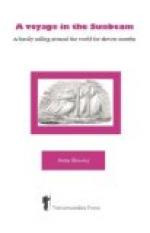There is a large and very good hotel here, l’Hotel Oriental. It is a handsome building outside, and the interior is full of marble courts, stone corridors, and lofty rooms, deliciously cool in the hottest weather. Having procured a carriage, Tom and I and the children drove through the streets, which are wide and handsome, though badly paved, and so full of holes that it is a wonder how the springs of a carriage can last a week. The houses seem built chiefly in the Italian style of architecture, with fine stucco fronts, and in many cases marble floors and facings, while the courtyards, seen through the grilles, blazed with flowers. All the lower windows were strongly barred, a precaution by no means unnecessary against the effects of the revolutions, which are of such frequent occurrence in this country. To enable the inhabitants the better to enjoy the sea-breeze, the tops of the houses are all flat, which gives the town, from a distance, somewhat of an eastern appearance. There are a great many Italian immigrants here, and most of the building and plastering work is done by them.
The Paseo del Molino is the best part of the town, where all the rich merchants reside in quintas, surrounded by pretty gardens. They are very fantastic in their ideas of architectural style, and appear to bestow their patronage impartially, not to say indiscriminately, upon Gothic cathedrals, Alhambra palaces, Swiss cottages, Italian villas, and Turkish mosques. Except for this variety, the suburb has somewhat the appearance of the outskirts of many of the towns on the Riviera, with the same sub-tropical surroundings. These are, however, hard times on the River Plate, and more than half the quintas are deserted and falling into ruins. On our way back, by the Union Road, we met a great many of the native bullock-carts going home from market. These huge conveyances are covered with hides, and are drawn by teams of from two to twelve bullocks, yoked in pairs, and driven by a man on horseback, who carries a sharp-pointed goad, with which he prods the animals all round, at intervals. Dressed in a full white linen shirt and trousers, with his bright poncho and curious saddle-gear, he forms no unimportant figure in the picturesque scene. In the large market-place there are hundreds of these carts, with their owners encamped around them.
When we at last arrived on board the yacht again, at three o’clock, we found that the miseries of coaling were not yet over, and that there had been numerous visitors from the shore. Everything on deck looked black, while below all was pitch dark and airless, every opening and crevice having been closed and covered with tarpaulin, to keep out the coal dust. It took seven hours to complete the work, instead of two, as was hoped and promised, so our chance of starting to-day is over. This seemed the more disappointing, because, had we foreseen the delay, we might have made other arrangements for seeing more on shore.




